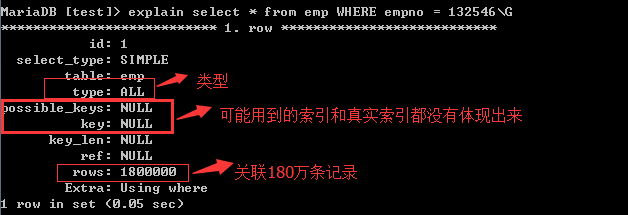一:什麼是索引 索引本身是一個獨立的存儲單位,在該單位裡邊有記錄著數據表某個欄位和欄位對應的物理空間。索引內部有演算法支持,可以使查詢速度非常快。 有了索引,我們根據索引為條件進行數據查詢,速度就非常快 1,索引本身有“演算法”支持,可以快速定位我們要找到的關鍵字(欄位) 2,索引欄位與物理地址有直接對 ...
一:什麼是索引
索引本身是一個獨立的存儲單位,在該單位裡邊有記錄著數據表某個欄位和欄位對應的物理空間。索引內部有演算法支持,可以使查詢速度非常快。

有了索引,我們根據索引為條件進行數據查詢,速度就非常快
1,索引本身有“演算法”支持,可以快速定位我們要找到的關鍵字(欄位)
2,索引欄位與物理地址有直接對應,幫助我們快速定位要找到的信息
一個數據表的全部欄位都可以設置索引
二,索引類型
1,四種類型:
(1) 主鍵 parimary key
auto_increment必須給主鍵索引設置,索引列的值要求不能為null,唯一
(2)唯一 unique index
索引列的值不能重覆,但允許有空值
(3)普通索引 index
索引列的值可以重覆。
(4)全文索引 fulltext index
Myisam數據表可以設置該索引
2,複合索引
索引是由兩個或更多的列組成,就稱複合索引或聯合索引。
三,創建索引
1,創建表時
1),創建一個member表時,並創建各種索引。
create table member(
id int not null auto_increment comment '主鍵',
name char(10) not null default '' comment '姓名',
height tinyint not null default 0 comment '身高',
old tinyint not null default 0 comment '年齡',
school varchar(32) not null default '' comment '學校',
intro text comment '簡介',
primary key (id), // 主鍵索引
unique index nm (name), //唯一索引,索引也可以設置名稱,不設置名字的話,預設欄位名
index (height), //普通索引
fulltext index (intro) //全文索引
)engine = myisam charset = utf8;
2),給現有數據表添加索引
alter table member add primary key(id); //註:一般設置主鍵後,會把主鍵欄位設置為自增。(alter table member modify id int not null auto_increment comment '主鍵';)
alter table member add unique key nm (name);
alter table member add index(height);
alter table member add fulltext index(intro);
3),創建一個複合索引(索引沒有名稱,預設把第一個欄位取出來作為名稱)
alter table member add unique key nm (name,height);
2,刪除索引
alter table 表名 drop primary key;//刪除主鍵索引
註意:該主鍵欄位如果存在auto_increment 屬性,需要先刪除。(alter table 表名modify 主鍵 int not null comment '主鍵')
去除去數據表欄位的auto_increment屬性;
alter table 表名 drop index 索引名稱;//刪除其它索引(唯一,普通,全文)
eg: alter table member drop index nm;
四、explain 查看索引是否使用
具體操作: explain 查詢sql語句
這是沒有設置主鍵索引的情形:(執行速度、效率低)

加上主鍵後:

五、索引適合的場景
1、where查詢條件(where之後設置的查詢條件欄位都適合做索引)。
2、排序查詢(order by欄位)
六、索引原則
1、欄位獨立原則
select * from emp where empno = 1325467;//empno條件獨立,使用索引
select * from emp where empno+2 = 1325467;//empno條件不獨立,只有獨立的條件欄位才可以使用索引
2,左原則
模糊查詢,like & _
%:關聯多個模糊內容
_:關聯一個模糊內容
select * form 表名 where a like "beijing%";//使用索引
select * from 表名 where a like "beijing_";//使用索引
select * from 表名 where a like "%beijing%”;//不使用索引
select * from 表名 where a like "%beijing";//不使用索引
3,複合索引 index(a,b)
select * from 表名 where a like "beijing%";//使用索引
select * from 表名 where b like "beijing%;//不使用索引
select * form 表名 where a like "beijing%" and b like "beijng%";//使用索引
4,or原則
OR左右的關聯條件必須都具備索引,才可以使用索引。
eg(index(a)、index(b))
select * from 表名 where a = 1 or b = 1;//使用索引
select * from 表名 where a = 1 or c = 1;//沒有使用索引



